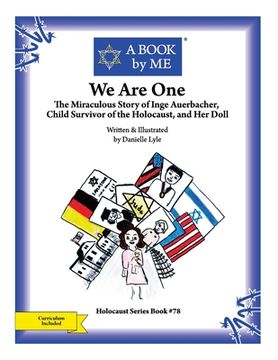We Are One: The Miraculous Story of Inge Auerbacher, Child Survivor of the Holocaust, and Her Doll (en Inglés)
Reseña del libro "We Are One: The Miraculous Story of Inge Auerbacher, Child Survivor of the Holocaust, and Her Doll (en Inglés)"
Inge Auerbacher was born in Germany on December 31, 1934. Sixty Jewish families, including Inge's, had lived there for over 200 years. Inge's father served during World War I. He was wounded and received the German Iron Cross for his bravery. No amount of patriotic service could make the Nazis respect the Jews as human beings. Jews were hated and blamed for Germany's troubles. Inge's grandparents lived a far away, but they visited often. For Inge's second birthday, they gave her a beautiful blond-haired, blue-eyed doll. Inge slept with the doll and took her everywhere. One day, Inge leafed through the pages of her mother's album of movie stars and pointed to a striking woman with blue eyes and blond hair. When she asked who the lady was, her mother answered, "That is Marlene Dietrich." Inge immediately said, "I will name my doll Marlene." Many years later as an adult, she learned that the factory's name for this style of doll was "Inge." The doll had been designed for the 1936 Olympics in Berlin. The peace of the Jewish community was shattered by Kristallnacht (Night of Broken Glass), a massive riot directed against the Jews in Germany and Austria on November 9th and 10th, 1938. A mob broke windows in the Jewish homes and stores. They demolished the inside of the synagogue and tore apart the holy scrolls, called "Torah" in Hebrew. Inge, her mother, and her grandmother saw it all from their living room, surrounded by broken glass. In the morning her father and grandfather were arrested and sent to Dachau concentration camp. Luckily, they were released after a few weeks. They spoke of the horrible treatment they had received. It was clear his patriotism and war medal would not help his family. Inge's family sold their home and moved in with her grandparents hoping they would find safety in another country soon. They were the only Jewish family in their village of a thousand people. By late 1941, all Jews age six and up were forced to wear the yellow Star of David sewn on their clothing. The star had the word Jude [Jew] on it, which marked them as outcasts. The family was increasingly frightened and their hopes of fleeing growing fainter. Six months later, the family was sent to a concentration camp where a guard ripped Inge's treasured Dutch boy pin from her coat, shouting "You won't need this where you're going!" He tore open her doll to search inside the hollow body for hidden valuables. Tears ran down Inge's cheeks as she watched, helpless. Satisfied that the doll was empty, the guard finally handed back her beloved Marlene. They were herded onto a crowded train and during the two-day trip, they were given little food. When they finally stopped, the guards ordered them to leave their belongings near the railroad tracks. Inge had her doll, Marlene, in her arms. Her family was sent to a large barrack to sleep on the concrete floor. Conditions at the Terezin concentration camp were harsh. Mice, rats, fleas, bed bugs, and lice were the inmates' constant companions. Meals consisted of a dark soup, a small portion of turnips, and a potato, with a small bread ration once a week. The people had to stand in long lines to get the meager food rations ladled into metal dishes. In all of this filth and hunger, Inge felt lucky that she had Marlene for company. The doll slept in a broken cardboard box near her head on the bunk. The war ended in Europe in May of 1945. Inge and her parents were finally able to immigrate to America in May of 1946. Eleven-year-old Inge was clutching the faithful Marlene when the family arrived in New York City where Inge still lives today. As for Marlene, she is now a symbol to the world of steadfast love and endurance. Inge donated Marlene to the United States Holocaust Memorial Museum in Washington, DC as a loving gift for all mankind.

